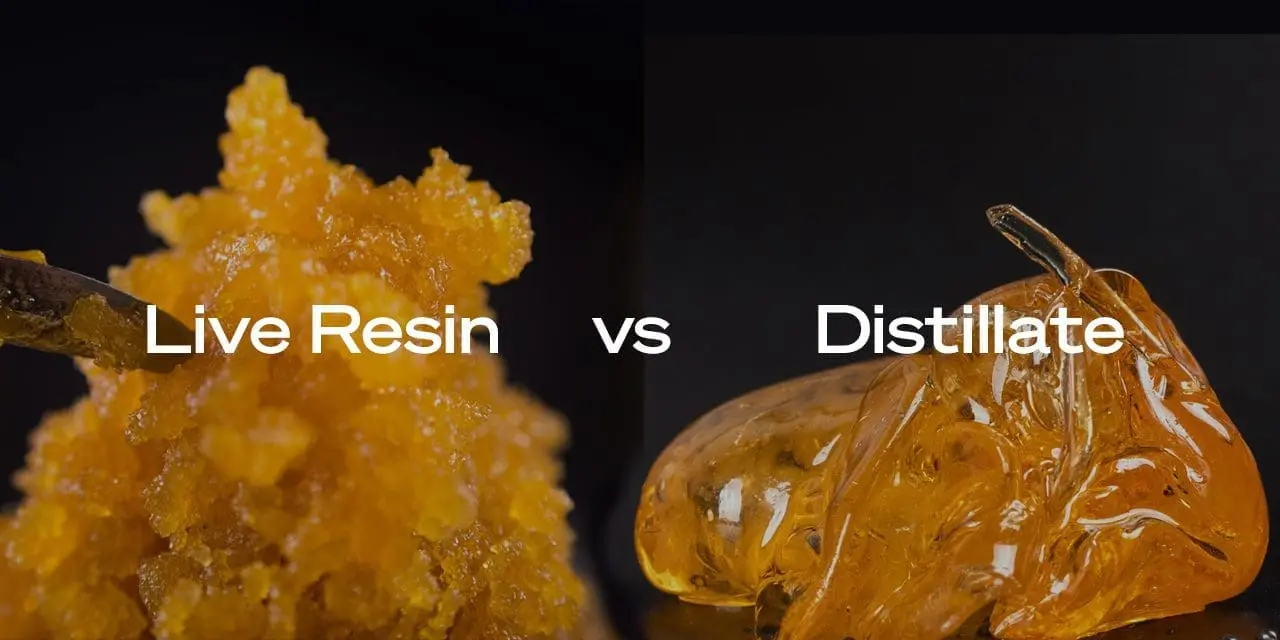What’s the difference between live resin and distillate?

Article written by

April AcernoContent Writer
Live resin and distillate are two common types of cannabis extracts that are most often vaporized. They can also be added to certain products, including edibles and tinctures.
Both live resin and distillate contain cannabis compounds that may benefit your health. However, they differ in strength and in the variety of compounds they contain.
It’s important to understand the difference between the two so you can choose the most suitable type of extract for your specific needs.
Differences between live resin and distillate
Live resin is a full-spectrum cannabis extract. This means that it contains a spectrum of naturally occurring compounds in cannabis, including cannabinoids, terpenes, and flavonoids, which give cannabis its flavor, aroma, color, and health effects.
The main difference between live resin and distillates is that live resin retains most of the plant’s original cannabinoids and terpenes, while distillates do not.
Distillate is a cannabis extract containing a high concentration of a single cannabinoid, such as tetrahydrocannabinol (THC) or cannabidiol (CBD). Distillates usually have a concentration of 90% or more of this cannabinoid and contain virtually no terpenes, flavonoids, or other compounds.
How they’re made (extraction process)
- Live resin: Making live resin starts with flash-freezing freshly harvested cannabis buds. By using flash-frozen instead of dried cannabis buds, the finished product yields a higher concentration of terpenes and flavonoids. Once the buds have been flash-frozen, they’re combined with a solvent, such as butane, to dissolve the beneficial compounds from the plant material into a thick, oily liquid that is processed into resin.
- Distillate: Unlike live resin, distillate is made from dry-cured cannabis flower buds. The buds are combined with a solvent to separate the compounds from the plant material. This yields a full-spectrum cannabis extract, which is then heated and cooled further to separate the desired cannabinoids in a process known as distillation.
How they look, smell, and taste
- Live resin: Live resin is flavorful and aromatic due to its high concentration of terpenes and flavonoids. Its texture varies from thick and syrup-like to waxy and sugary, and it is usually golden to amber in color.
- Distillate: Distillate is transparent, flavorless, and odorless due to its lack of terpenes and flavonoids.
Their effects
- Live resin: Live resin contains all of the cannabinoids, terpenes, and flavonoids in cannabis. This may give live resin a wider range of health benefits through the entourage effect, a theory that suggests cannabis compounds have greater benefits when consumed together than they do when used in isolation. The experience with live resin may be more complex and longer lasting than distillate, according to some users.
- Distillate: Distillate provides a concentrated form of a single cannabinoid, like THC or CBD. This means that you’ll only experience the effects of that particular cannabinoid, which can be ideal for certain symptoms or conditions, but may lead to a more intense, short-lived, and less nuanced cannabis experience.
Connect with a licensed physician online in minutes.
Similarities between live resin and distillate
Live resin and distillate share certain similarities.
The products and forms they come in
Both live resin and distillate can be added to most cannabis products, including:
- Vapes and cartridges
- Edibles
- Tinctures
- Topicals
- Pre-rolls
- Concentrates, aka dabs
Your product’s label will state which type of extract is used.
Their potential risks and side effects
Neither live resin nor distillate is riskier than the other. That said, both live resin and distillate can be very high in THC, potentially causing side effects like:
- Dry mouth
- Dizziness
- Drowsiness
- Confusion
- Anxiety
- Paranoia
Live resin and distillate are also both made with solvents. All reputable cannabis companies publish third-party laboratory test results confirming their formulas are clean of residual solvents. If you can’t find evidence of these tests, look for a different product supplier.
How to decide which is best for you
Choosing the best extract comes down to personal preferences and your goals with cannabis.
Live resin may be a good choice if you’re seeking the effects of all of the compounds in cannabis, including its variety of cannabinoids, terpenes, and flavonoids. Live resin is also a flavorful extract that can produce a nuanced, enjoyable cannabis experience.
Distillate products may be a good choice if you’re seeking potent effects of a single cannabinoid, such as THC or CBD. Distillates are great in topical formulas, providing targeted relief to sore muscles or painful joints. They might also be the right option if you don’t want as much flavor or aroma in your product, such as when you’re making your own edibles.
Live resin products tend to be more expensive than distillate products, but this price difference varies depending on your location and available offers.
The bottom line: Live resin is full-spectrum, while distillate highlights a certain cannabinoid
Live resin and distillate are two popular types of cannabis extracts that can be found in edibles, vaporizers, and more.
They share some similarities, but they differ in the cannabis compounds they contain, how they might affect you, and how they’re made.
If you need help deciding whether live resin or distillate is better for your needs, a Leafwell telepharmacist can help you weigh the pros and cons.
Get your medical marijuana card
Resources
- A comprehensive review on the techniques for extraction of bioactive compounds from medicinal cannabis. https://www.mdpi.com/1420-3049/27/3/604
- Processing and extraction methods of medicinal cannabis: A narrative review. https://link.springer.com/article/10.1186/s42238-021-00087-9
Frequently asked questions
Find answers to common questions about live resin vs. distillate.


